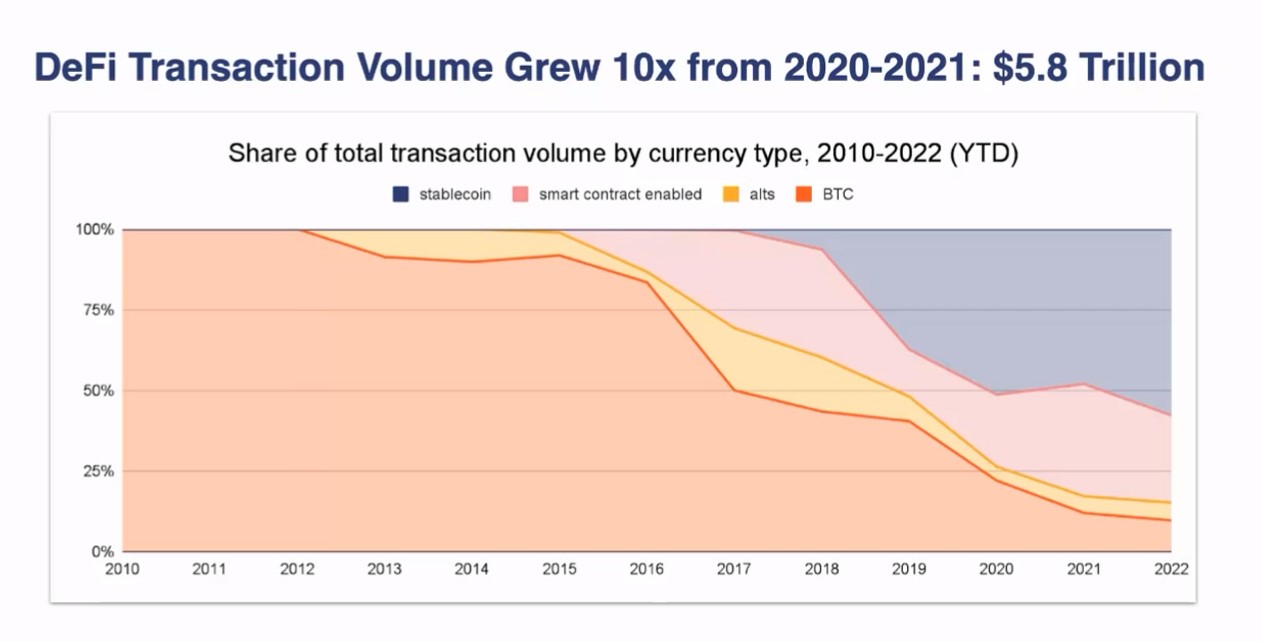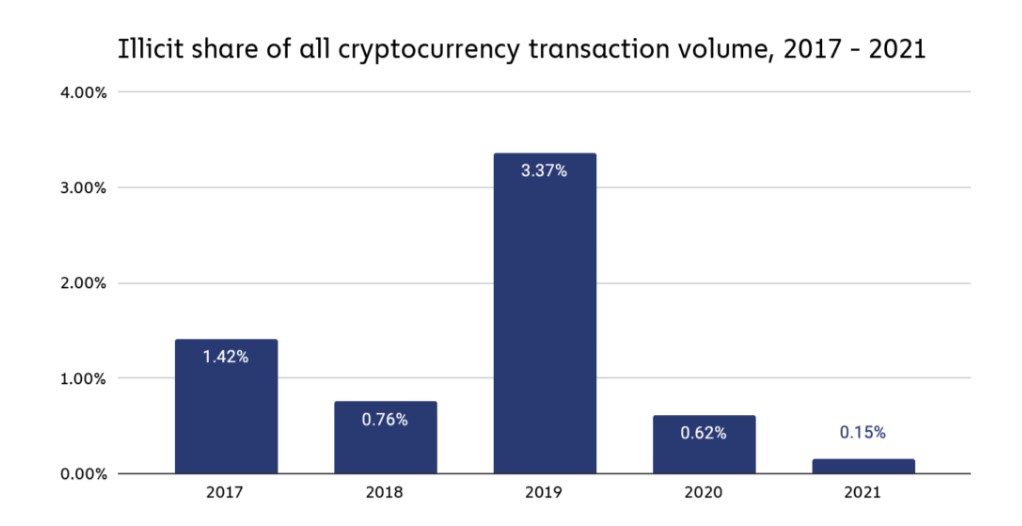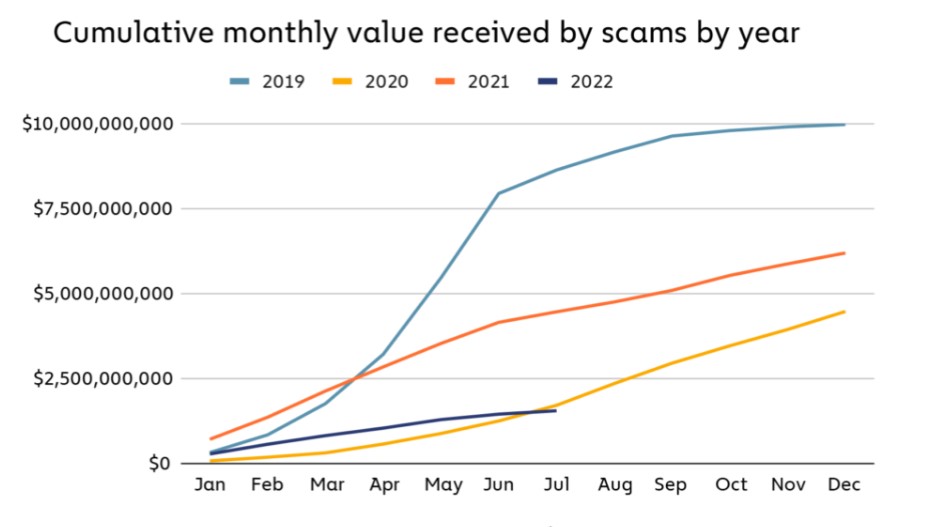
- The share of illicit crypto activity associated with illicit wallets is the lowest in five years.
- DeFi protocols dominate as the main target of hacks.
- The monthly value received by crypto scams is declining.
The year 2022 was anything but boring. A stablecoin crashed, lending protocols vanished, crypto empires crumbled, and the harsh bear market settled.
Nevertheless, the use of digital currencies is evolving and keeps moving rapidly. But as the crypto space constantly changes, so does the criminal world.
Sponsored
DailyCoin talked to Diederik van Wersch, Director of Mid-Market EMEA at blockchain analysis firm Chainalysis on the latest trends in crypto-based crimes, why they occur, and how one can prevent them.

Source: Web3summit.lt (Photo by Gediminas Gražys)
Criminal Activity: Smaller, but Still Resilient Part of Web3
In 2021, crypto-related crimes reached a record $14 billion of the total value transferred on the blockchain. The number is almost twice as high compared to the $7.8 billion of the previous year.
Despite this, the share of all illicit crypto transaction volume was the lowest in five years. Since both legitimate and illicit crypto markets generated $15.8 trillion in transactions throughout the year, the criminal transfers represented 0.15% of all economic activity in the cryptocurrency space.
Sponsored
This is three times less than 2020 and 21 times less than 2019. But the decline is only one side of the coin. The other side marks a dramatic change in illicit activity forms and, most importantly, targets.
DeFi Dominates Transfer Volumes
Increasing crypto adoption, institutional demand, more efficient smart contracts, and high-yield financial products made Decentralized Finance (DeFi) one of the crypto ecosystem’s fastest-growing and most attractive sectors.
The volume of transactions on DeFi grew ten times over the past few years. The total value locked on DeFi protocols reached an all-time high of more than $181 billion in the last days of 2021.
Once the dominant asset behind all crypto transactions, Bitcoin lost the leader’s position to stablecoins and smart contract-enabled coins, which transferred the highest volumes of value.

Source: Chainalysis.com
DeFi is the Leading Target of Hackers
This year, we have seen an unprecedented rise in hacks, specifically of DeFi protocols,” says van Wersch.
According to him, more than 95% of hacks in 2022 happened on Decentralized Finance (DeFi), marking the continuing trend that started a year ago. In 2021, DeFi surpassed the centralized exchanges and emerged as an absolute leader among victims of hacks.

Source: Chainalysis.com
The amount of funds stolen from DeFi hacks in the first half of 2022, $1.9 billion, has already exceeded the record of over $1 billion set in the third quarter of 2021.
Today, the total value stolen from DeFi protocols throughout the year is more than $3.2 billion, according to crypto data provider DeFiLlamma. In October, hackers implemented 11 attacks and stole $718 million worth of crypto from various DeFi protocols. Meanwhile, the total amounts stolen from centralized exchanges barely touched $250 million and kept a tendency to decline.
"Centralized exchanges were sitting on a large amount of crypto, and criminals got access to the private keys. Now virtually all hacks are happening on decentralized exchanges or decentralized platforms rather," says van Wersch.
Decentralized exchanges (DEXes) transferred more value than their centralized counterparts for the first time since the start of 2022.
The surge in DEX activity took off even more after the crash of Terra (LUNA) in May 2022, making them one of the most active sectors and the dominant way of value transfers in the crypto space.
Hackers Target Code Vulnerabilities
According to data provided by van Wersch, at least half of DeFi hacks can be associated with code exploits because of the protocols’ open-source nature.
“The reason for that is because the protocol’s code is public. It is very easy for criminals to spot if there is a vulnerability or exploit in the public code and siphon it off the platform”, van Wersch says.
Earlier this year, his firm identified code exploits and security breaches as the dominant attack vectors, responsible for the biggest percentage of funds stolen from DeFi protocols.

Source: Chainalysis.com
He further admitted that North Korea accounts for 60% of all DeFi losses of the year. North Korea-related hacker groups, mostly the state-sponsored Lazarus Group, stole about $1.9 billion worth of digital assets from DeFi protocols over the year’s first half.
The US Department of Justice alleged the Lazarus Group stole $625 million from the Ronin blockchain, which powers Axie Infinity. The hack implemented in March 2022 was the largest known theft of cryptocurrency to date.
DeFi Exploited for Money Laundering
Stealing funds through exploits is only one dominating trend of how DeFi protocols have been exploited over the year.
Money laundering has surged in popularity in 2022, making DeFi the main source of washing illegally obtained funds.
“70% of all money laundering right now in the cryptocurrency space is going through decentralized platforms,” says van Wersch.
According to Chainalysis reports dated January 2022, nearly $8.6 billion in digital assets were laundered throughout decentralized exchanges, cross-chain bridges, and coin swap services in 2021.
This is 30% more compared to the previous year, yet only 0.4% of the $2 trillion and $800 million of total value laundered annually.
Illicit World Benefits on the Lack of Regulation
One of the reasons why money laundering through the crypto space has become attractive to financial fraudsters is that DeFi protocols are decentralized. This means they are not obliged to comply with the Anti-Money Laundering (AML) and Know Your Customer (KYC) rules.
Such regulations are mandatory on centralized crypto exchanges. As more and more crypto service providers adopt these rules, criminals are drawn to look for unregulated and more anonymous alternatives to move illicit funds.
“I think this is because it is a nascent piece of technology, so the criminals feel like, “ok, they don’t have the same types of AML checks. It means that it’s much easier to launder their funds there,” says the Head of Mid-Market EMEA at Chainalysis.
According to Van Wersch, DeFi will continue to represent a high proportion of money laundering in cryptocurrency over the coming year.
On the other hand, he believes that the numbers will eventually diminish as law enforcement agencies and investigators become more proficient in investigating illicit transactions on DeFi.
“Key point to remember is that fundamentally the blockchain is open, transparent, and public. The blockchain itself is a fantastic tool to combat money laundering because every transaction is visible. Criminals might think they’re smart for using DeFi platforms, but there are always gonna be means by which we can catch them,” he assured.
Crypto Scams Declining
In post-pandemic 2022 the macroeconomic situation changed drastically. Russia invaded Ukraine, and energy prices correspondingly spiked, triggering inflation and restricted financial policies across the planet.
In the crypto space, bears took over from the wild bulls of 2021. Profits were wiped out and turned into losses. Crypto prices dropped, but consequently, so did the number of scams.

Source: Chainalysis.com
According to Chainalysis data, the monthly value received by scams in mid-2022 was $1.6 billion. This is almost 65% lower than a year ago. Furthermore, the number is the lowest in the past four years.
"Scams are one of the most often types of cryptocurrency crimes. Those are on the decline right now. Last year, as we were in the bull market, scams saw a significant increase," says van Wersch.
According to him, this happened because the general public was less interested in crypto during the bear market. As fewer potential victims enter the space, it naturally becomes less interesting for scammers.
“However, this is short-lived, and I think this will only last as long as we are in the bear market. Once we enter the bull market again, once the market is hot again, and once there are a lot of different projects on the rise, that’s when criminals are gonna take advantage of the naivety that exists in the space,” the expert added.
Due Diligence to Mitigate Risks
According to the Chainalysis executive, any token that holds value may become a target of fraudsters. As long as the criminals feel they can convert DeFi tokens to some other tokens to fund illicit activities, they will try to do so.
“There’s always gonna be that risk,” says van Wersch. “So if you’re gonna invest in DeFi protocol, do your due diligence behind it. Make sure you are using platforms that are not only clean from an AML perspective but also look clean in the sense that they have been certified, and the code is structurally sound.”
